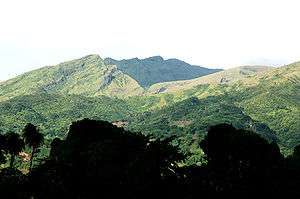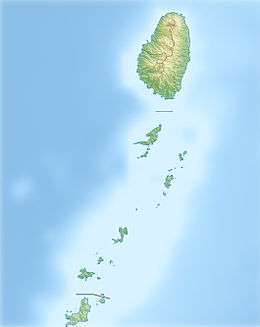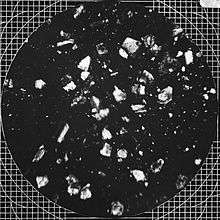La Soufrière (volcano)
La Soufrière (Vincentian Creole: Soufray) or Soufrière Saint Vincent is an active volcano on the island of Saint Vincent in the Windward Islands of the Caribbean. Many volcanoes in the Caribbean are named Soufrière (French: "sulfur outlet"). These include Soufrière Hills on Montserrat and La Grande Soufrière on Guadeloupe, the subject of Werner Herzog's 1977 film La Soufrière.
| La Soufrière | |
|---|---|
 | |
| Highest point | |
| Elevation | 1,234 m (4,049 ft) [1] |
| Prominence | 1,234 m (4,049 ft) [1] |
| Listing |
|
| Coordinates | 13°20′N 61°11′W |
| Naming | |
| Native name | Soufray |
| Geography | |
 La Soufrière Location in Saint Vincent and the Grenadines | |
| Location | Saint Vincent, Saint Vincent and the Grenadines, West Indies |
| Geology | |
| Mountain type | Stratovolcano (active) |
| Volcanic arc/belt | Lesser Antilles Volcanic Arc |
| Last eruption | April to October 1979 |
| Climbing | |
| Easiest route | From the windward (Atlantic) side |
Geography and structure
At 1,234 m (4,049 ft), La Soufrière is the highest peak on Saint Vincent as well as the highest point in the island country of Saint Vincent and the Grenadines.[1] Soufrière is a stratovolcano with a crater lake and is the island's youngest and northernmost volcano.
Eruptive history

La Soufrière violently erupted in 1718, 1812, 1902, 1971, and 1979. The Saint Vincent eruption of 6 May 1902, just hours before the eruption of Mount Pelée on Martinique, killed 1,680 people. The death zone, where almost all persons were killed, was close to entirely Carib. This last large remnant of Carib culture was destroyed,[2] the island of Dominica's Carib Territory being much smaller in comparison at that time.
The last recorded eruption was in April 1979; due to advance warning there were no casualties.
A famous painting by J. M. W. Turner of the eruption on 13 April 1812 belongs to the Victoria Gallery & Museum, University of Liverpool.[3] [4] [5]
References
- "La Soufrière" on Peakbagger.com Retrieved 1 October 2011
- Frederick Albion Ober, Our West Indian Neighbors: The Islands of the Caribbean Sea, " America's Mediterranean", 2010 republish of 1908 book by Nabu Press ISBN 978-1-145-31194-7 book
- Victoria Art Gallery Archived 21 July 2015 at the Wayback Machine on view July 2015
- ‘The Eruption of the Souffrier Mountains, in the Island of St Vincent, at Midnight, on the 30th of April, 1812, from a Sketch Taken at the Time by Hugh P. Keane, Esqre’, Joseph Mallord William Turner, exhibited 1815 | Tate
- The Eruption of the Soufrière Mountains in the Island of St Vincent, 30 April 1812 | Art UK
External Links
- The University of the West Indies Seismic Research Centre
- Smithsonian Institution's Global Volcanism Program | Soufrière St. Vincent
- USGS/CVO West Indian Volcanoes (Dead link)
- UND Soufriere St. Vincent (Dead link)